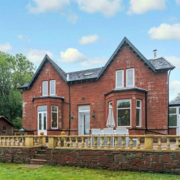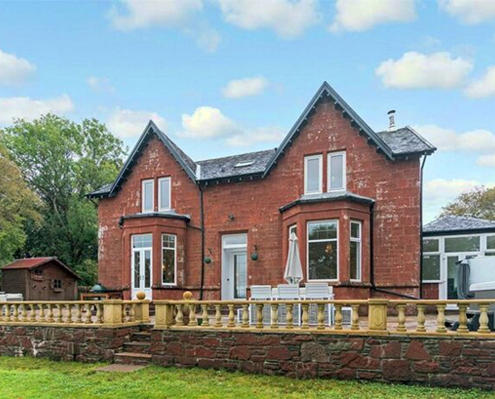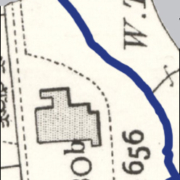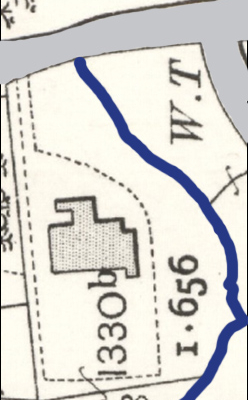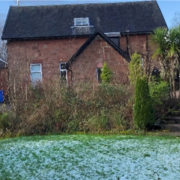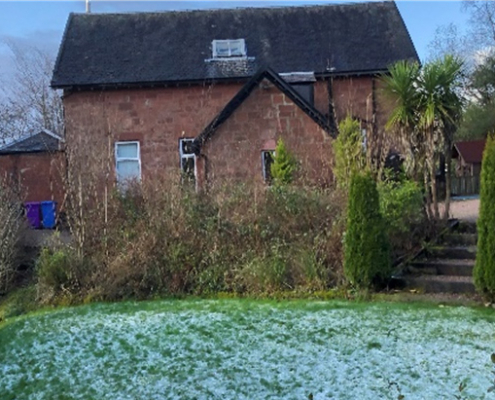Glengyron, 34 High Road / Skelmorlie Castle Road
Pictures:
Photos: 1 & 3 – Houses for sale and rent: Listing Oct 22 – Glengyron from the west and east. 2. 1910 Ordinance survey with Skelmorlie Castle Road at the top and Halketburn Road in top right corner.
| Owners | Dates |
|---|---|
| Misses Georgina & Margaret Vallence | c.1887 – c.1910 |
| Mr Samuel McNaught | c.1910 – c.1917 |
| Mr Robert Tweeddale | c.1917 – c.1932 |
| Mr Alexander Miller | c.1932 – c.1944 |
| Mrs Mary Christie followed by Mr Leslie and Mrs Margaret Walker | c.1944 – c.1984 |
About the house:
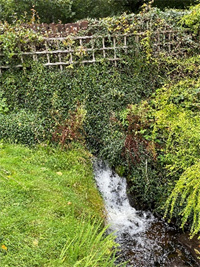
Glengyron Garden
Glengyron is a two-storey red sandstone villa situated on the seaward side of Skelmorlie Castle Road (once known as the High Road), between Mount Pleasant to the north and Halketburn Road to the south.
At some point over the last 30 years, the land between the actual Halketburn which runs through the property, and Halketburn Road itself (marked W.T. in the 1910 ordinance survey map above) was sold and a modern two storey house built, called Castleburn. [24]
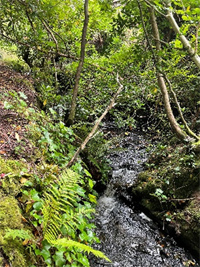
Glengyron Garden
Glengyron faces west to make the most of the sea views and is accessed from Skelmorlie Castle Road to the east. Skelmorlie’s lower reservoir was on the opposite side of the road and the water from the Halketburn emerges from under the road on the east and meanders its way down through the property in a small ravine (approx. 30 – 40 feet below the level of the house) exiting at the southwest corner of the property. On the other side of the burn is Castleburn (see above) and Invereoch. Birchburn Cottage once stood at the bottom of the garden to the west of the property.
On entering the house through the main door, the dining room and kitchen are off to the left, and the lounge, study and cloakroom are off to the right. The staircase with its highly decorative newel post and wrought iron spindles, rises from the far end of the hallway. [24]
As is usual, the two main public rooms (the lounge and the dining room) have decorative cornicing and matching central roses. The cornicing and rose in the latter is unusual, as it depicts seashells. [24]
Most rooms in the house would have originally had a fireplace, and the rooms used by the owners, would have also had a bell push to summon assistance. In Glengyron these led to the kitchen. Each kitchen bell was a different size so that the servants would know which room was calling. [24]

Photos:1. Staircase. 2. Cornicing in Dining Room. 3. Door from conservatory back to living room 4. Ladder staircase to attic bedroom. Source: Current Owner and ND
From the living room there is a small door cut through the 2-foot external wall through to the conservatory. [24]
At the rear of the property there is a utility room (originally the laundry) and above it, accessed by a ladder staircase, an attic bedroom once used by live-in servants. Opening off the laundry room is a small yard which once housed the coal shed. [24]
Upstairs there are four bedrooms and a bathroom.[24]
About the owners:
We don’t know who built Glengyron, nor who it was built for. The ground would have certainly been purchased from the Earl of Eglinton and Winton, who originally owned most of the land north of the Meigle and south of the Kelly.
There is mention of Mount Pleasant in the 1881 census (albeit unfinished) but not of Glengyron and we’ve been unable to locate the house in the 1885 valuation roll although there are plenty of new houses in the upper village without names. Many of these houses had the same owner (investor or developer) but they are either empty or being tenanted by a painter, joiner, plumber etc. From this we conclude that the house was completed after 1885 and that the Vallance sisters were the first owners of Glengyron. [1][2]
c.1887 – c.1910 Misses Georgina and Margaret Vallance
Georgina Agnes Pinkerton Vallance was born in 1843 and her younger sister Margaret Rebecca Maxwell Vallance five years later in 1848. Their parents were Reverend James and Margaret (McWalter) Vallance, both from Paisley. James & Margaret married in July 1835 and initially settled at his living in Scoonie, Fife and then moved to Tinwald Manse in Dumfriesshire sometime between 1845 and 1848. [3]
James and Margaret had a large family of 3 boys and 5 girls: James (1835), Ann (1838), Alexander (1840), Georgina (1843), Janet (1845), Margaret (1848), Grace (1851) and Thomas (1852). The first 5 children were born in Scoonie and the other at Tinwald Manse. [3][4]
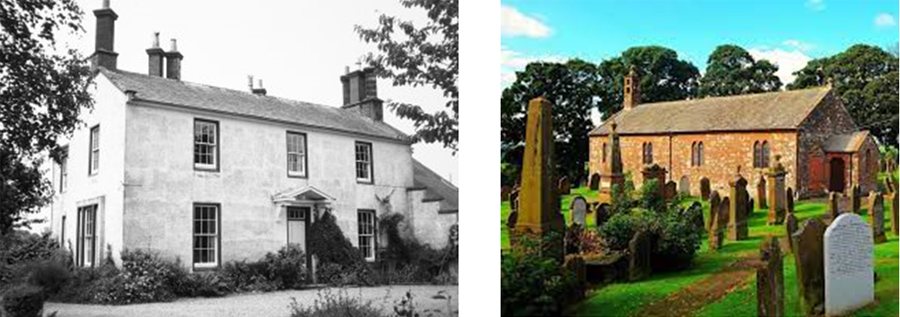
1. Tinwald Manse. Source: Canmore
2. Tinwald Parish church. Source: KTTChurch.org.uk
Tinwald Manse is described today as a grand, six-bedroom detached house, with a one and a half storey north wing, located on the outskirts of the village of Tinwald. It’s a B listed property built in 1837 and remained as a Church of Scotland Manse until 2017 when it was put up for sale. [5][6]
The Vallances lived in the 17 roomed (more than one window) Tinwald Manse from the late 1840s until James’s death in 1889, aged 80. At this time, he was still the Minister of the church but by then a widower. [3]
In the 1851 census, we find James and Margaret at home with seven of their children from James the eldest who was 15 years old to Grace the youngest, who was just 2 months old. Georgina was 8 and Margaret 2. There are 5 live in servants – one assigned to the farm, 3 to the house and 1 laundress. [4]
At the time of the 1861 census James is not at home. His eldest son James had died a few months earlier aged just 25 and had been buried in the churchyard. Present at the time of the census was Margaret, then 47, with the remaining six children. Georgina was 17 and had finished her schooling and Margaret was 12. There was only one live-in domestic servant. [3][4]
By 1871, James (58) and Margaret (56) were at home with only Margaret (22) and Grace (20). There are 2 live-in domestic servants. Ten years later it is just James (68) and his daughter Janet (33) with one live in domestic. [4]
Without the original deeds for Glengyron, we can only estimate that the sisters purchased Glengyron around 1887. [1]
At the time of the 1891 census, both sisters were at Glengyron living off their own means. Georgina was 39 and head of the household and Margaret was 34. There is one live in domestic, Helen Jane Lester. From the census we also learn that Glengyron has 10 rooms with one or more window. [2]
Although it was Georgina and Margaret who owned the property, at the time of the 1901 census Georgina (49) was at home but rather than Margaret, it was Grace (39) staying with her. There were no live-in domestics. [1][2]
Glengyron was still owned by Georgina and Margaret in 1905 but by 1911 census, the sisters were staying at Craiglie Drive, Morningside, Edinburgh, suggesting that they had already sold and moved. [1][7]
c.1910 – c.1917 Mr Samuel McNaught
By linking our next owner’s details given in the 1915 valuation roll, we’ve been able to locate his 1911 and 1921 census entries, as well as his marriage and death certificates. [8]
From these documents we learn that Samuel McNaught was born in 1862. His father, Thomas Govan McNaught was in the police force, and rose to the rank of detective inspector by the time he died. His mother was Jessie (Temple) McNaught. [9]
Samuel married Margaret Forsyth Johnson in December 1892 when he was 30 and she was 25. The wedding was held at her family home, Giffnock Farm. At the time Samuel gave his occupation as commercial traveller (travelling salesman). [9]
A year later Lillias Struther McNaught was born and seven years after that in 1900, Margaret gave birth to a boy, Alfred Stanley McNaught. [9]
By 1911 the family is staying at 40 Holmhead Road, a semidetached villa in Cathcart. Samuel was then 48 and an Iron and Steel Merchant, Margaret was 43, Lillias 17, and Alfred 11. No-one is staying at Glengyron [10]
We know that Samuel McNaught owned Glengyron by 1915 from the valuation roll. Because Samuel also gave his address as 129 Trongate, Glasgow, we believe that Glengyron was most likely a holiday home. Samuel’s ownership of Glengyron is relatively short lived as by 1920 (valuation roll) the house has a new owner. [8]
Before leaving the family, our research shows that by 1921 the McNaught’s have moved and are living at ‘Duncairn’ 25 Sherbrooke Avenue, a large, detached property in Pollockshields. Samuel (58) was still an Iron and Steel Merchant, his son Alfred (21) was a mechanical engineer. Both Margaret (53) and Lillias (27) are at home. [10]
The family continued to move up the housing ladder. By the time Samuel died in February 1927, he was living at 1 Davieland Road in Whitecraigs. A stunning detached villa overlooking Rouken Glen park. His ownership of Glengyron in Skelmorlie must have made quite an impression as he had named his Whitecraigs home “Glengyron”. [9]
c.1917 – c.1933 Mr Robert Tweeddale
Back in Skelmorlie, our next owner was Robert Stewart Tweeddale who was born in 1869 in Pettinain, a small hamlet in south Lanarkshire to James Tweeddale, farmer, and Jane (Paterson) Tweeddale. [11][12]
In 1903 when he was 34 and a ‘Bank Fellow’ living in and presumably working in Dalkeith he got married. His bride was Sarah Nesbit Stoddart, aged 24, who lived in Cockpen, 3.5 miles from Dalkeith, daughter of John, a retired estate factor and Sara (Liddell) Stoddart. They were married by the minister of Lasswade, a small village close to their homes and the wedding itself took place in the Balmoral Hotel in Princess Street, Edinburgh, rather than in one of their homes. [11]
The couple had two children that we know of; George Nesbit Tweeddale born in 1910 in Lasswade and Sarah Margaret Tweeddale who was born in Newington in 1914. [11][13]
Some time between 1915 and 1920, the family moved to Glengyron in Skelmorlie.[8]
From the 1921 census we learn that Robert was a ‘Bank Agent’ working for the Clydesdale Bank, presumably on the Shore Road in the village. At the time, Robert was 50, Sarah 40, George 11, and his sister 7 years old. They have one live in servant Margaret Plank, aged 22 from Armadale. [13]
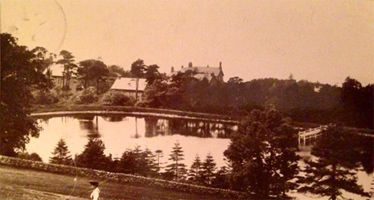
Skelmorlie lower reservoir. Circa 1910.
Source: Valentine postcard Facebook: SK and WB in their heyday
The family were still living in Glengyron in 1925 at the time of the Skelmorlie Reservoir Disaster, which tragically killed 5 people.
Glengyron is built on a rocky foundation, directly opposite the reservoir on Skelmorlie Castle Road. In the 1910 Valentine postcard, we can see how close the lower reservoir is to the village. [14]
On the day in question, Mr Tweeddale stated that when coming up the road at lunch time he observed that the water in the burn (Halketburn) was running very rapidly and was muddy. [15][16][17]
He suspected there was something wrong but thought no more about it until an hour later, when having just finished lunch, he heard a roar like thunder. Looking out the window he was astonished to see the water from the burst dam swirling all-round the house. [15][16][17]
Mrs Tweeddale and the children ran out of the house to flee from danger, but unable to make their way through the water they returned inside. The house escaped damage, but the garden walls were completely torn away, and some outhouses impacted. [15][16][17]
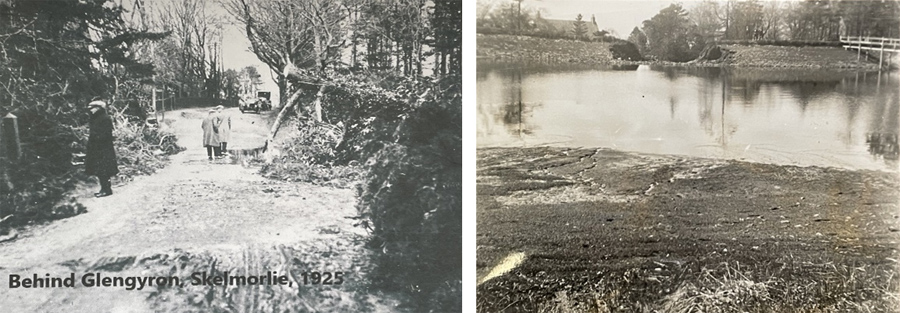
Photos: 1. The High Road behind Glengyron, Skelmorlie 1925. Facebook: SK & WB in their Heyday. 2. The reservoir after the breach with Glengyron in the background. Largs Museum
The Tweeddale’s stayed at Glengyron until sometime between 1930 and 1935 possibly when Robert retired, after which the couple moved to Giffnock where Sarah died in 1939 and Robert a year later in 1940, aged 71. [11][12][18]
c.1933 – c.1944 Mr Alexander Miller FRCS
Alexander Miller was born in Carluke in 1904 to Andrew Miller, Master Butcher, and Sarah McMillan (Cook) Miller. He was educated at Allan Glen’s School (Secondary) and Glasgow University where he graduated M.B. (Batchelor of Medicine) Ch. B (Batchelor of Surgery) in 1928.[19][20]
After university he was appointed to the resident staff of the Victoria Infirmary where he developed a strong interest in orthopaedic surgery. He obtained his higher qualifications F.R.C.S. (Fellow of the Royal College of Surgeons and F.R.F.P.S (Fellow of the Royal Faculty of Physicians and Surgeons) in 1931 and moved back to Victoria Infirmary a couple of years later. In the intervening period he’d worked and studied in England under some eminent surgeons of the day and it’s in England he is likely to have met and married his wife Constance Doris Lewis. [19] [20]
Alexander Miller purchased Glengyron sometime between 1930 and 1935. As the property appears to have been bought for his mother Sarah Miller, who is listed as the tenant in both the 1935 and 1940 valuation rolls, the purchase is likely to occurred just after his father Andrew, died in 1933. [18][19]
Whilst his mother lived in Skelmorlie, Alexander continued to live in Glasgow firstly in Royal Terrace (1935) and then Woodside Crescent (1940). [18][19]
Around 1944, Glengyron was sold, and Sarah moved to near Rutherglen where she died 15 years later in 1959, aged 80. Alexander and his wife lived close by at Jacton and sadly he died just 3 months after his mother when he was only 55. [18]
c.1944 – c.1984 Mrs Mary Armour Christie followed by Mr Leslie & Mrs Margaret (Christie) Walker
Mary Armour Marshall (Sharpe) Christie was born in Glasgow in 1879 to James Grossard Sharpe, Publican and Margaret (Linklater) Sharpe. [21]
In November 1912 she married George Tait Christie in the Wigtown Established Church when she was 33 and George 34. Prior to the wedding, both lived in Wigtown where George was the local station master and Mary a housekeeper. Two years later Mary gave birth to a daughter Margaret Emily Christie at the station house (railway) in Wigtown. [21]
By 1921 (census) the family were still living at the station house in Wigtown. George was 42. Mary was 41, and Margaret was six and an only child. Soon after this the family moved to Crieff where George was again Station Master, and by 1927, they’d moved to Wemyss Bay with George’s job and the family lived in the Station House. [22][23]
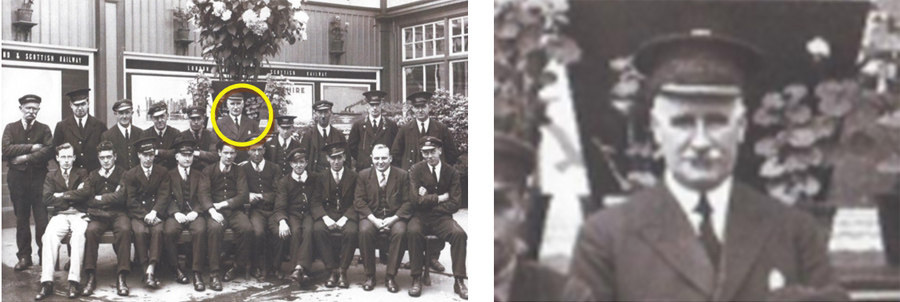
George Christie, Wemyss Bay Station Master and his staff – Friends of Wemyss Bay Station – Nov 2020
George continued as Station Master until his death in 1942, aged 63. At this point Mary and Margaret had to vacate the station house and they moved temporarily to a flat round the Bay close to the Episcopal Church/Cross. [23][24]
Around 1944, Mary purchased Glengyron for herself and Margaret. Sadly, Mary didn’t have long in the house before she died in 1945, aged 65. [21]
Margaret who’d graduated from Glasgow School of Art, continued living at Glengyron. She worked for Ministry of Food located in the Westburn sugar refinery in Greenock. It was here that she met George Leslie John Walker (known as Leslie) who was a mechanical engineer at the refinery. The couple got married in the South Parish church in February 1948 and went on to have three children all born at home: Norman Edward 1949, Kathleen Rosemary (known as Rosemary) 1951, and Ian Christie 1954. [21][24]
For the Walker family, Glengyron became a lovely family home, full of special memories. Once the children had grown up and flown the proverbial nest, Margaret and Leslie continued living at Glengyron until 1984, when they moved to North Somerset. Margaret died in December 1996, aged 82 and Leslie died in April 2014, aged 99 and 9 months. [21][24]
1984 – Present
Glengyron has changed hands at least three times since 1984, most recently in October 2022. At some point, the plot of land at the corner of Skelmorlie Castle Road and Halketburn Road was sold, and a modern two storey house built. [24]
.
Sources and References:
[1] 1885, 1895 and 1905 Valuation roll
[2] 1891, 1901 censuses
[3] Vallance family birth, death, and marriage certificates
[4] 1841, 1851, 1861, 1871 and 1881 Censuses – Tinwald
[5] Canmore: https://canmore.org.uk/site/65875/tinwald-manse
[6] Facebook: Church of Scotland Properties for Sale – Tinwald Manse – 6th September 2017
[7] 1911 census – Morningside
[8] 1915 and 1920 Valuation Rolls
[9] McNaught family birth, death, and marriage certificates
[10] 1911 census – Cathcart &Skelmorlie, 1921 census – Pollockshields.
[11] Tweeddale family birth death and marriage certificates
[12] 1920, 1925 and 1930 Valuation Rolls
[13] 1921 census – Glengyron, Skelmorlie
[14] The Scotsman digital archive: Skelmorlie reservoir bursts five lives lost – Monday 20th April 1925
[15] The Glasgow Herald: Monday April 20th, 1925- Hillside reservoir bursts
[16] The Largs and Millport Weekly news, Saturday April 25, 1925
[17] Skelmorlie by Walter Smart, 1968
[18] 1935 and 1940 Valuation Rolls
[19] Alexander Miller’s birth and death certificates
[20] Obituary of Alexander Miller, M.B., Ch.B., F.R.C.S., F.R.F.P.S. – The British Medical Journal 21 Nov 1959.
[21] Christie & Walker family birth, death, and marriage certificates.
[22] 1921 census – Wigtown
[23] 1925, 1930, and 1935 valuation roll – Wigton and Inverkip
[24] Input from Norman Walker (family home) and the current owner John Alexander
[25] Houses for sale & Rent – Glengyron Listing Oct 22.

